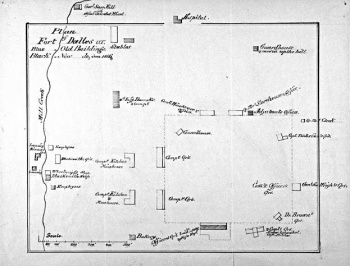Fort Dalles
|
Fort Dalles (1847-1867) - Originally established from a stockade by volunteer troops at the Dalles, Wasco County, Oregon, 1847-1848 as Fort Wascopum named for the Methodist Mission there. Also called Fort Lee (3) for Major Henry A.G. Lee of the Oregon Rifles. Established as a Federal post on 20 May 1850 and named Camp Drum (1) after Capt. Simon H. Drum (Cullum 597), 4th U.S. Artillery who was killed 13 Sep 1847 during the Mexican War at Mexico City. In April 1853. Camp Drum became Fort Drum (1) and in July 1853 it was designated Fort Dalles. Abandoned 22 May 1867 and transferred to the Interior Department 28 Mar 1877.
HistoryThis regular U.S. Army fort was used during various Indian disturbances from 1850 to 1866 including the Cayuse War and the Yakima War. The original construction was of poor quality and by 1854 was deteriorating rapidly. Colonel Joseph K.F. Mansfield visited Fort Dalles 26-30 Aug 1854 as a part of his inspection tour of Western military facilities and he describe the hospital as "miserable" and the officer's quarters as "bad and all of logs". At the time of his visit, the post strength was 47 men. After treaties signed with the Indians at Walla Walla in 1855 failed, the fort was rebuilt in 1856 and served as a regimental headquarters for the recently activated 9th U.S. Infantry under the command of Colonel George Wright. Fort Dalles became a major military depot for Fort Walla Walla and Fort Simcoe and a central point for military activities in eastern Washington and Oregon during the Yakima War. Supplying these posts was a huge logistical operation requiring about 200 civilians and some 700 public animals with supply trains in constant operation during 1856-1858. Military strength at the Fort in 1856 was four companies numbering 11 officers and 275 enlisted men. The Fort Dalles reservation encompassed 10 square miles (640 acres) and overlapped the original Methodist Mission land claim. It covered most of the land of present-day Dalles, Oregon. The Dalles was important because it was one of two rapids along the Columbia River that could not be navigated and where everyone had to disembark and portage around the rapids. It was also the crossroads for the Oregon Trail and other roads and the only northern route into the Willamette Valley. Protecting the Dalles was vital to the operation of the Oregon Trail and the supply of other military posts. The new buildings at Fort Dalles were designed by architect Louis Scholl who also designed Fort Simcoe. The fort consisted of frame buildings laid out in a semi-circle and was not stockaded. The construction at the fort came under criticism for being overly extravagant, especially in the construction of the carpenter-gothic Commanding Officer's quarters and quarters for the other senior officers. U.S. Civil War (1861-1865)In 1861, at the beginning of the U.S. Civil War, Federal troops were withdrawn and sent back east. Fort Dalles was non-functional until 1862 when volunteer troops were assigned. From 1862 to 1866 Fort Dalles was garrisoned by these volunteer troops. The new wooden buildings on the fort were susceptible to fires because of their location on a hilltop and the almost constant wind that could fan the flames. Running water was not available on the post and fire apparatus were not available. Several buildings succumbed to fire even before the post was abandoned, on 24 Oct 1864 one of the officer's quarters burned, and on 23 Dec 1865 the Commanding Officer's quarters burned to the ground. Fort Dalles was last garrisoned from 22 Mar to 22 May 1867 and then abandoned. On 28 Mar 1877, the remaining military reservation was transferred to the Interior Department. Commanders:
Current StatusThe 1856 surgeon's quarters have been restored and are open for view, it is the only remaining original building. The museum and store are housed in a period building that connects to the surgeon's quarters.
See Also: Sources:
Links: Fortification ID:
Visited: 15 Nov 2008, 11 Oct 2005 Picture Gallery
| |||||||



